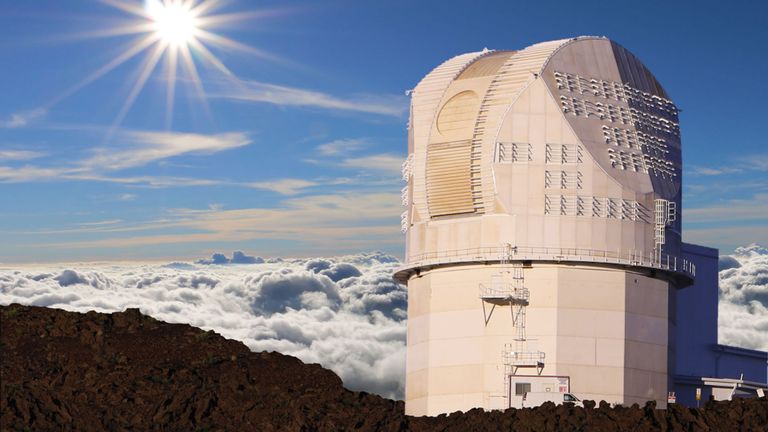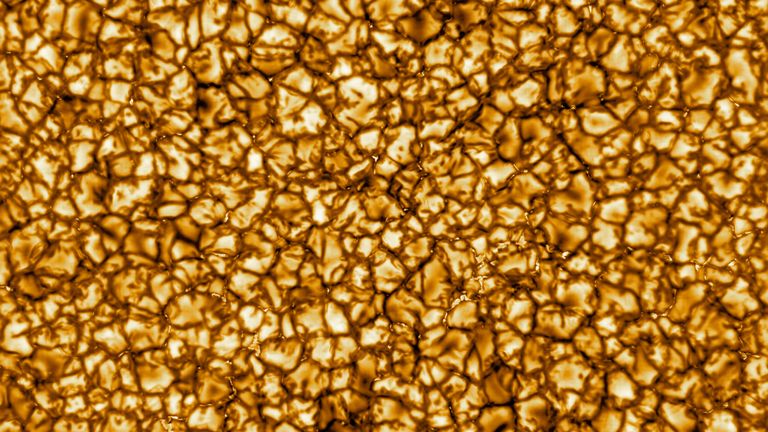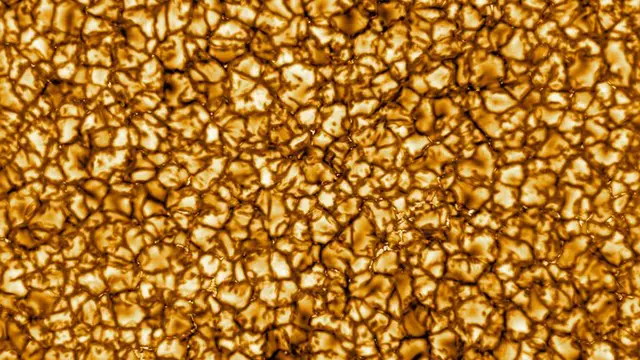The surface of the sun has been revealed in detail thanks to pictures from a solar telescope in Hawaii.
The Daniel K. Inouye solar telescope has produced the highest resolution images of the
star's surface
ever taken, which will help scientists to understand how the sun impacts Earth.
The National Science Foundation says that activity on the sun's surface can affect "air travel, disrupt satellite communications and bring down power grids, causing long-lasting blackouts and disabling technologies such as GPS".

Image:The solar telescope in Hawaii. Pic: NSO/NSF/AURA
The NSF has found patterns of turbulent boiling plasma that covers the surface, in cell-like structures, each the size of the state of Texas in the US.
Those structures are the "signature of violent motions that transport heat from the inside of the sun to its surface".
France Cordova, NSF director, said: "Since NSF began work on this ground-based telescope, we have eagerly awaited the first images.
"We can now share these images and videos, which are the most detailed of our sun to date. NSF's Inouye Solar Telescope will be able to map the magnetic fields within the sun's corona, where solar eruptions occur that can impact life on Earth.
"This telescope will improve our understanding of what drives space weather and ultimately help forecasters better predict solar storms."

Image:The first picture of the surface of the sun taken by the Daniel K. Inouye telescope. Pic: NSO/AURA/NSF
The telescope is a four-metre solar telescope which is in Maui,
Hawaii
. It was renamed after former senator Daniel Inouye who represented Hawaii from 1963 until his death in 2012.
The NSF said about him: "Senator Inouye was a tireless proponent of science, technology, engineering and math, especially when it came to enriching the lives of the people of Hawaii."
Matt Mountain, president of the Association of Universities for Research in Astronomy, which manages the instrument, said: "On Earth, we can predict if it is going to rain pretty much anywhere in the world very accurately, and space weather just isn't there yet.
"Our predictions lag behind terrestrial weather by 50 years, if not more. What we need is to grasp the underlying physics behind space weather, and this starts at the sun, which is what the Inouye Solar Telescope will study over the next decades."

Image:US Senator Daniel K. Inouye, after whom the telescope was renamed in 2013
In 2017, a space weather event which occurred at the same time as Hurricane Irma brought down radio communications used by first responders, aviation and maritime channels for eight hours on the day the hurricane made landfall.
Scientists hope a better understanding of space weather will allow for earlier notification of the impact on Earth, and that warnings could come as much as 48 hours before impact, instead of the 48 minutes currently managed.
David Boboltz, a program director in NSF's Division of Astronomical Sciences who oversees the facility's construction and operations, said: "These first images are just the beginning.
"Over the next six months, the Inouye telescope's team of scientists, engineers and technicians will continue testing and commissioning the telescope to make it ready for use by the international solar scientific community.
"The Inouye Solar Telescope will collect more information about our sun during the first five years of its lifetime than all the solar data gathered since Galileo first pointed a telescope at the sun in 1612."
 简体中文
简体中文

